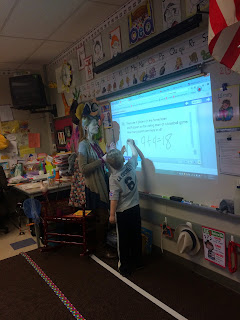Introduction -
The interactive whiteboard is an instructional tool the instructor to manipulate
the interactive elements on the board by using his finger(or a pen) as a mouse,
directly on the screen. Items can be dragged, clicked and copied and the
lecturer can hand write notes, which can be transformed into text and saved.
They are used throughout schools and offices.
Interactive white boards are teaching and learning tools used to display
and interact with the content. A device driver is usually installed on the
attached computer so that the interactive whiteboard can be interacted with
using a finger as a mouse is used at a computer. The computer's video output is
connected to a digital projector so that images may be projected on the
interactive whiteboard surface.
They are a powerful tool in the classroom adding interactivity and
collaboration, allowing the integration of media content into the lecture and
supporting collaborative learning. Used innovatively they create a wide range
of learning opportunities. However, in many environments they are not being
used to their full potential, and in many cases acting as glorified
blackboards.
Benefits:
- Capturing and saving notes written on a whiteboard to the connected PC.
- Capturing notes written on a graphics tablet connected to the whiteboard.
- Controlling the PC from the white board using click and drag, markup which annotates a program or presentation.
- Using an Audience Response System so that presenters can poll a classroom audience or conduct Quizzes, capturing feedback onto the whiteboard.
- Giving demonstration, Teachers can improve their presentation and demonstrations by drawing on different materials like multimedia, notes, drawing, and the internet.
- Using built in maps to teach geography. Teachers can drop in and drop out map images on the board for effective interactions.
- The teacher can call upon the students to interact with the whiteboard themselves. The lecturer can sit at the computer, with the student at the whiteboard, and the class offering suggestions and contributing ideas.
- Interactive whiteboards promote group discussion and participation. They are an effective tool for brainstorming as notes made on the screen can be turned into text, and saved to be shared and distributed later. They are an ideal tool for small group work and collaborative learning, as students can huddle around the board developing ideas, and then save the work for sharing over a network or by email.
- Online interactive:Touch-friendly online whiteboard apps are available that lets you use your computer, tablet or smartphone to easily draw sketches, collaborate with others and share them with the world.
Interactions Whiteboard Providers:
There are many interactive whiteboard companies which provide their own software’s,
video, image, and lesson libraries, below listed are few:
SMART, best-selling interactive whiteboard. A leader in introducing touch
technology into the classroom.
Promethean offers an integrated system that packages the interactive white board,
Learner Response System, lesson design and delivery software and online support
and professional development.
Mimio is a system that creates an interactive whiteboard out of a standard
whiteboard. For districts that are trying to manage tight budgets and already
own whiteboards, Mimio is a good option. It also includes online training and
certification.
Polyvision’s eno board can be used as a traditional marker board, a magnetic board, or
an interactive white board with no plugs or cables. It promises the lowest
total cost of ownership for schools and districts looking for the most
affordable interactivity. http://www.polyvision.com/.
Free online Interactive white board tools:
Sketchlot: is a free collaborative whiteboard service that works on any device that
has a web browser. Each student is assigned his or her own password to use to
join a drawing shared by his or her teacher. Teachers can create as many
drawings as they like and share them on an individual basis. Teachers can share
their drawings to one or all of their students at a time.
Real-time Board: The service allows working with any information and visual content on one
board individually or with the team. You can draw, work with images, post
videos, post and mark PDFs, write notes, and comment on materials through the
use of colorful post-it stickers.
History -
The first interactive whiteboards were developed
by Xerox Parc around 1990. This board was used in small group meetings
and round-tables.
Then in 1991, Smart board introduced their
first interactive board, which was simply an LCD screen attached to a computer.
By the late 1990s, a number of improvements had
been made on the design, including the addition of an eraser, colored markers
and back-lighted projection.
In 2001, eInstruction released its first
fully mobile interactive whiteboard. It used wireless technology to allow free
movement. This allowed instructors to teach from anywhere in the classroom and
removed the limitations put on the technology when it was tethered to the
computer system.
In 2009,
eInstruction released a system of remotes and mini-boards that allow students
to interact with the larger classroom board from their desks.
References -





No comments:
Post a Comment